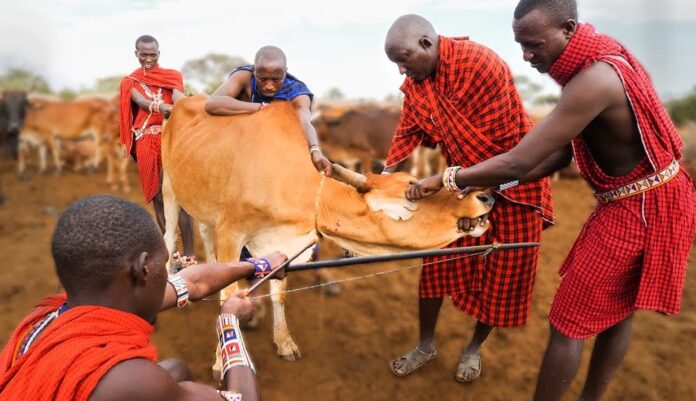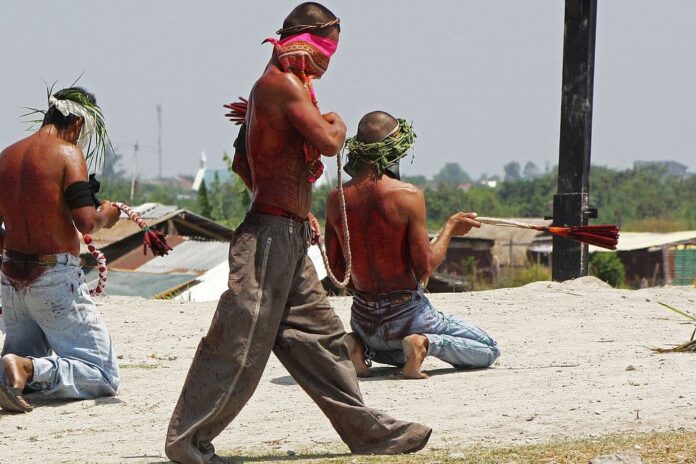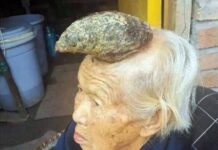From religions to traditions, there are bizarre rituals from many places around the world. If you have never seen such things before, you will totally freak out when you come across one. Some of these bizarre rituals involve people torturing themselves while others do the unbelievable. The majority of the bizarre rituals we are talking about today have been passed down for generations. Despite the fact that those rituals are disturbing to watch, there are still people who practice them today. Brace yourself and find out which one is the most bizarre ritual of them all with me.
1Ainu Bear Worship

Where: Japan & Russia
The Ainu people, indigenous to Japan and Russia, have this peculiar custom of sacrificing bears. The people believe that bears are gods, so sacrificing the bears mean blessing the souls of mankind. Bear Festival aka Iyomante literally means “to send something / someone off”. In some villages in Japan, the festival is varied in names such as Kumaokuri (sending off the bear) or Kumamatsuri (the bear festival).
As for the bears, the people choose the ones that are still hibernating at the end of winter. If they find a newborn cub, they will kill the mother then take the cub back to the village. The villagers then raise the cub indoors as if they are their own children. When the cub grows larger, they put it into a small pen made of logs and raise it outdoor instead.
After two years, the people then release the cub from the cell then place it in the center of the village. The villagers then tie the bear to a post with a rope before the males shoot the cub with bows and arrows. Usually, it takes numerous shots before the bear falls and becomes too weak to defend itself. Then and only then, one villager will approach the bear and shoot it in the neck point-blank to ensure that it is dead.
That is not the end, the villagers then slit the bear’s throat and drink the blood from the poor cub. When the ritual is done, the people skin the bear while the meat is distributed amongst the villagers. The thing is that the Ainu people love bears and feel sorry for their deaths, but they still do not give up this cruel ritual.
2Cutting Off Fingers

Where: Papua New Guinea
When: Funeral
Crying is not the best way to express grief and pain when your loved one passed away if you are in Papua New Guinea. The Dani Tribe in this country cuts off the tips of their fingers in order to demonstrate their sorrow. Exclusive to the women of the tribe, they would amputate the top joint of the finger upon the death of a loved one.
Before amputation, they would wrap a string tightly around the top half of the finger for half an hour. Doing so is to numb the finger and reduce the pain before cutting their fingertips. Then they would cauterize the open wound to stop bleeding and infection as well as to create a new fingertip. The bizarre part is that sometimes losing a finger does not fully convey their sense of grief.
On some rare occasions, the mourners may also chop off an ear, cover themselves in river sludge, or go for weeks without showering. Although this practice has been banned in recent years, you will still find some older members of the tribe continuing the tradition.
3Drinking Cow Blood

Where: Southern Kenya, Northern Tanzania
In the southern part of Kenya as well as Northern Tanzania, there is an indigenous tribe known as The Maasai. This tribe highly values cattle, and they always drink cow blood on special occasions. Those include the birth of a baby, the circumcision of a child, a girl’s marriage, and many more. They also use cow blood as the remedy to alleviate intoxication and hangover as well.
Because they respect their cattle, they have their unique ways of drinking blood from the cow. Using a bamboo shoot, they cut the vein of a cow and suck the blood from it. By doing so, the cow doesn’t have to die to sacrifice blood to humans at all. Some people puncture the loose flesh on the cow’s neck with an arrow, either way, both are bizarre.
4Dropping Babies
Where: India
When: Within two months after the baby was born
How does that sound? The title of this ritual simply explains the whole process of the ritual, dropping the babies. In India, parents of newborn babies drop their infants off the roof of a 30 feet tall shrine. They believe that doing so will give their babies good health, and the ritual has been around for almost 700 years now. The terrified infants will be hurtled through the air before being caught in a sheet by waiting men.
Legend has it that a saint advised people whose babies were dying to build a shrine, and drop the ailing infants. Doing so is to show their trust in the almighty. When the parents did so, the babies were miraculously cradled to safety in a hammock-like sheet that appeared in midair. Since then, prayers for the birth of a healthy baby in the region promised to toss the baby as an offering to the god.
Both Hindu and Muslim parents participate in this dangerous ritual, and they believe that it will ensure good health and prosperity for their families. As for now, the practice appears to be extremely rare where only isolated villages in Maharashtra are still doing it. The good thing is that the organizers claim that no injuries have ever been reported which is nice to know.
5Endocannibalism

Where: Papua New Guinea
When: A family member has passed away
Perhaps this term is new, but it goes nowhere away from the word that it is combined with. Endocannibalism is the practice of eating the flesh of a human being from the same community after they died. In Papua New Guinea, members of the Fore tribe eat the flesh of the dead out of respect. They believe that they can absorb the loved one’s wisdom through this ritual.
In this tribe, women and children played the largest role when it comes to cannibalism as part of the funerary rites. There are certain protocols that the members have to follow. For example, a woman had to eat her brother’s brain or the hands of her brother-in-law. That is because the consumption of each body part symbolized a different attribute the consumer could take on. There are several tribes that still practice this ritual, and this means of addressing grief is surely a bizarre one.
6Living with the Dead

Where: Indonesia
When: A family member passed away
Sometimes it is not easy to accept the fact that our loved ones have gone to another world. In Indonesia, the Torajan people keep the bodies of their relatives at home with them up to years after their deaths. With their dead relatives in the house, they often provide the dead with food, water, and even cigarettes on a daily basis. They do so because they believe that the spirit remains near the body and craves for care.
This can take months or even up to years before a funeral takes place. The members take care of the deceased as if they were sick which includes washing, changing clothes, and talking. Also, the family members never leave the dead alone at all, and the lights are always on for them when it gets dark. The people believe that if they don’t take care of the corpses properly, the spirit of their departed will give them trouble.
Traditionally, people used special leaves and herbs to rub on the deceased’s body for preservation. Now, they inject formalin, the preserving chemical, instead of using the traditional way. Formalin leaves a powerful chemical reek in the room. Yet love is bigger than anything, so the smell does not really matter. There is a death tour that tourists can plan a trip to the funeral rites and see everything for themselves.
7Self-Flagellation

Where: Iraq
When: Ashura
Ashura is the holiday that is on the 10th day of the Islamic month Muharramhe Islamic calendar. Ashura is considered by Sunni Muslims for two reasons: Muhammad fasted and Moses fasted. As for Shiite Muslims, they mark Ashura as a day of mourning for the Prophet Muhammad’s grandson, Imam Hussein. Many of them travel to Karbala in Iraq as a pilgrimage on Ashura, and most of them wear black.
They gather at mosques and shrines, or in processions for ceremonial mourning that involves “matam” aka beating their chests. Usually, they march through the streets chanting and hitting themselves in the chest. Some use whips and chains as well as other sharp objects to hit themselves in the back and other body parts. Meanwhile, the others slap their own faces with other various things to punish their bodies during this ritual.
Doing so is to reflect the grief over the violent deaths of Hussein and his family. As for the participants in the processions or convoys in the streets, they carry colorful flags and sing hymns dedicated to Hussein. In India, the government bans Ashura processions by placing barriers and imposing curfews in some major cities during Ashura.
8Self-Immolation

Where: Tibet
When believed that something is wrong, Tibetan monks always lit themselves on fire. Since March 2009, there have been more than 140 people set themselves on fire inside Tibet to protest against the repressive Chinese occupation. The thing is that although many monks and nuns have set themselves alight, most of them are not from religious institutions. Most of them are teachers, students, herdsmen, teenagers, and the youngest of which was 15 years old. Before the practice, they usually left written and recorded messages to show their purposes of self-immolation.
9The Gloves

Where: Amazon Forest
When: A boy wants to become a man
There are many ways for a boy to enter manhood, but the Sateré Mawé tribe takes this to a whole new level. This tribe lives in the Amazon rainforest of Brazil, and their rite of passage is super painful. All boys of the tribe must endure great and excruciating pain to be accepted as men. The tribe believes that any boy who wants to become a man must experience the worst pain the jungle has to offer.
The offer would be the pain from the string of Paraponera Clavata aka the Bullet Ant. For those who are not aware, bullet ants are one of the ants that have the most painful sting on earth. Just like the name suggests, the pain is compared to being shot with a bullet. And the boys of the tribe have the wear gloves full of those ants. Also, the pain continues up to 24 hours; receding and returning regularly.
During the ritual, the Mawé submerge hundreds of bullet ants into gloves made of leaves with their stingers pointing towards the inside of the gloves. Then those young men will have to wear the gloves and undergo the ritual that lasts for full five minutes. During those 5 minutes, the boys will experience endless stings by hundreds of ants repeatedly. After the gloves are removed, the boys will likely to be in pain and shake uncontrollably for hours.
If you think that is the end, you are wrong. To fully complete this initiation and be accepted as a man by the tribe, the boys must endure this practice a total of 20 times. That will be over the course of months or even years, so much to take a be a man, isn’t it? This cruel trial is to get the boys ready for the traditional life of the Mawé. When you live in a dangerous forest like the Amazon, sweet sixteen is not in the list.
10Vegetarian Festival

Where: Southeast Asia
When: On the last day of the 8th lunar month of the Chinese calendar
How nice the name is, too bad this vegetarian festival collides nowhere near the peaceful and calm veggies that you think. Phuket Vegetarian Festival aka the Nine Emperor Gods Festival is celebrated primarily by the Chinese community in Thailand and around Southeast Asia. During the festival, people abstain from meat for 9 days, doesn’t sound so bad right? However, there is much more than that.
To honor the animals, the participants practice self-mutilation as well as many other bizarre things to themselves. Some shove sharp objects like swords, hook, large spears, and knives through their mouths and cheeks. There are less painful practices as well such as walking on hot coals and climbing ladders, made of knife blades.
There are rules to participate in the festival that devotees must follow. Those include wearing clothes, keeping pure thoughts, giving up meat, sex, alcohol, stimulants, and strong foods like garlic. If you are tourists, you are very welcome to attend and take photographs. As for those are in mourning as well as pregnant and menstruating women, they are not supposed to attend the rituals.



